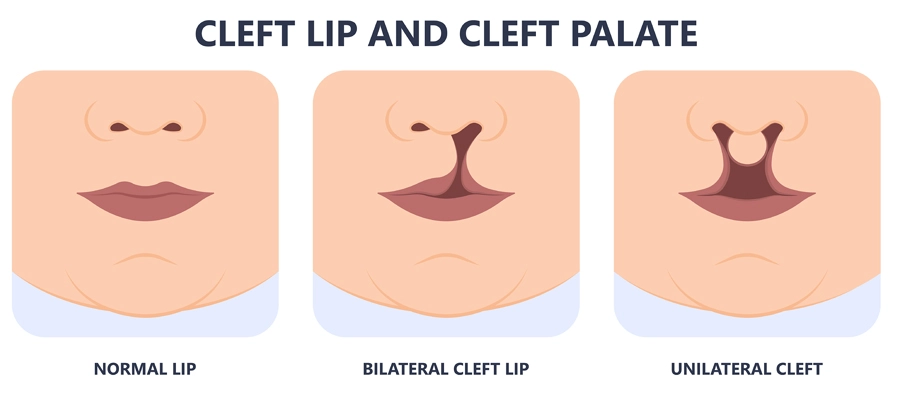What are cleft lip and cleft palate?
A cleft is a fissure or a gap. The cleft of the lip can be small or partial and looks like a cleft in the lip. A full cleft will stretch to the nose. A unilateral cleft occurs on the right or left side of the upper lip. A bilateral cleft affects both sides. A cleft palate occurs when the two parts of the skull that make up the hard palate do not fuse. The soft palate also has a gap or cleft. A full cleft palate can also result in a void in the lip, while an incomplete cleft palate appears as a break in the roof of the mouth. Most conditions can be corrected with limited scarring thanks to advanced surgery.
If left uncorrected, a cleft lip or palate can lead to:
- Dental problems
- Ear infections and possible hearing loss
- Feeding difficulties
- Low self-confidence
- Speech problems
A team of specialists, from the GP to a speech therapist, will work to help a child with a cleft because it can cause a variety of developmental problems.

Symptoms of Cleft Lip and Palate
The main symptom is the presence of the cleft at birth. A cleft lip can be as small as a small notch on the upper lip. It could also be as large as a slit or a hole that goes up to the nose. A cleft palate could be just a small area that is not formed correctly. But there could also be a big gap on the palate. Children with clefts often have other health problems. They may have trouble eating and speaking. They may also have hearing issues, ear infections, or dental issues.
Causes of Cleft Lip and Palate
Cleft palate and cleft lip have no clear cause, but physicians suspect they are caused by genetic and environmental causes. Genetics may play a role in the development of clefts if one or both parents pass on a gene that makes cleft palate or lips more likely. What you do during your pregnancy can also make your child more likely to have a cleft lip or palate
Factors that scientists believe can cause the development of a cleft to include:
- Smoking cigarettes
- Drink alcohol
- Use illegal drugs
- Not getting enough prenatal vitamins, such as folic acid
A cleft may be an isolated birth defect or part of a broader genetic disease, such as van der Woude syndrome or velocardiofacial syndrome, all of which are inherited malformations.
Complications of Cleft Lip and Palate
- Feeding problems :
Ear infections and hearing loss are more common in children with a cleft palate, as they are more vulnerable to fluid build-up in the middle ear. Babies usually learn to eat quickly, and feeding is not a problem.
- Speech problems :
Children with a cleft palate may also have trouble speaking. These children's voices are not well transmitted, the voice may acquire a nasal sound, and speech may be difficult to understand after palate repair. Not all children have these problems, and surgery can completely fix them.
- Dental issues :
Children with cleft palates are at risk for a variety of dental issues, including:
- A greater number of cavities
- Missing, extra, malformed, or displaced teeth that need treatment.
- A defect in the alveolar ridge, the bony upper gum that contains the teeth. A socket defect can: shift, tilt, or rotate permanent teeth; prevent permanent teeth from appearing; avoid the formation of the alveolar ridge; and cause premature loss of erupting canine and incisor teeth.
Diagnosis of cleft lip and palate
Cleft palate and the cleft lip can be diagnosed while your baby is still in the womb using ultrasound. An ultrasound uses high-frequency sound waves to create a picture of your baby inside your abdomen. If your doctor discovers that your baby has a cleft palate or lip while in utero, they may want to remove some of the amniotic fluid that surrounds your baby to be tested for other genetic abnormalities, such as van der syndrome. Woude.
Treatment of Cleft lip and Palate
The severity of your child's cleft palate or lip will determine the course of treatment. Treatment often involves multiple surgeries to close the opening and rebuild the face. A team of specialists can work with you and your child.
- Surgery :
Surgery to repair a cleft lip or palate is ideally done in your child's first year. However, additional reconstructive surgeries may be required until well into adolescence
- Cleft lip :
It is recommended that your baby's cleft lip be repaired when he is between 10 weeks and 1 year old. If your child's cleft is especially large, his or her doctor can recommend a lip adhesion, which entails briefly stitching the cleft shut so a surgeon can perform the repair. Your infant will be anesthetized during surgery, and a surgeon will enlarge the lip and close the gap using tissue and skin on both sides of the cleft lip.
- Cleft palate :
When an infant is between the ages of 6 and 18 months, surgeons conduct surgery to correct a cleft palate. During surgery, the muscles and tissue on the two sides of the roof of the mouth connect to close the cleft.
Risk Factors of cleft lip and palate
- Family history Parents with a family history of cleft lip or palate face an increased risk of having a baby with a cleft.
- Exposure to certain substances during pregnancy Cleft lip and palate may be more likely to occur in pregnant women who smoke cigarettes, drink alcohol, or take certain medications.
- There is some indication that women who are diagnosed with diabetes before being pregnant are more likely to have a baby.
- Being obese during pregnancy. There is some evidence that babies born to obese women may be at increased risk for cleft lip and palate.

